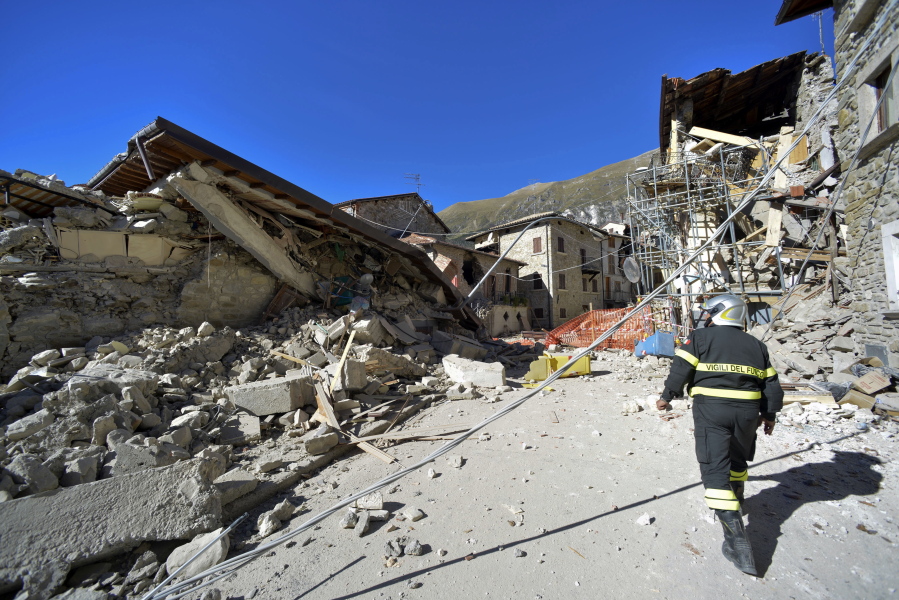CASTELLUCCIO DI NORCIA, Italy — Some houses are collapsed outright, pancaked piles of stones and plaster. A pair of skis stick out. Some are cracked open neatly, exposing rooms frozen in time.
The central Italian mountain village of Castelluccio di Norcia, among the most heavily hit by Sunday’s earthquake, is known for the beautiful blossoms of its lentil fields and its historic charm. Now it’s a ghost town.
With the roads cut off, almost all of the 300 inhabitants were evacuated by helicopter. They all survived after an earlier quake in August prompted them to move into safer housing like camper vans or containers.
But a small group of 13 hardy souls refuses to leave. Mostly farmers, they want to stay close to their cattle, sheep and horses — their livelihood, without which they would truly have nothing left to come back for.
“Practically we’ve returned to the stone age,” said Augusto Coccia, 65.
He was among the farmers housed in containers in the town square, eating breakfast, when the earthquake struck. It bounced the containers about and filled the air with a fog of dust.
The 6.6-magnitude tremor, the country’s most powerful in 36 years, pulled down buildings and historic churches in villages across the Appenine mountains. In Castelluccio, the ground is now as much as two feet lower, according to the national geophysics institute.
This town’s plight was worsened by the fact that the roads were cut off. Rescue helicopters brought in the bare necessities on Sunday but little else.
Coccia and the others who stayed behind cook under the open sky with gas canisters. They have no heating, electricity or constant water supply. The temperature drops to as low as 20 degrees Fahrenheit at night.
“The medical supplies were delivered to us today. It’s been three days since we requested them but it’s very hard to get them to us,” he said.
Besides helicopter, the only way to get to Castelluccio is by four-by-four through rough terrain. Some residents of the area made the trip, as did forest rangers, with whom The Associated Press traveled.
Among those making their way to Castelluccio on Tuesday was Vincenzo Brandimarte, 63. He had recently built an inn here using modern earthquake-resistant planning — and it was one of the very few buildings that did not collapse or crack.
“Today I began to cry when I saw the town with my own eyes,” he said. “This is worse than war. If it had been a real war maybe the town wouldn’t have been destroyed to this extent.”
As of Tuesday, 15,000 people from the region some 62 miles north of Rome were being given shelter. That’s on top of 2,000 who remain displaced from a quake in August, which left 300 dead.
Premier Matteo Renzi visited the town of Preci with his wife to survey the damage, meet some of the displaced people and participate in an open-air mass for All Saints’ Day.
“We will rebuild everything in a timely manner,” he said, according to news agency ANSA. He called on people to accept the offer of relocation, stressing the police presence had been beefed up to avoid looting and that tents are not a long-term solution in winter.
But farmers like Coccia argue it’s not an option, as they do not want to leave their herds alone. Wolves are a problem, in particular for sheep. The animals need barns within weeks to be able to withstand the cold.
As rescue operations proceeded Tuesday, aftershocks continued at a rate of several per hour, keeping people on edge. The strongest on Tuesday morning was felt as far away as Rome. Damage was also reported in the Italian capital where small cracks appeared in the ceiling of the Saint Eustache church and the marble of a street lamp near the Vatican was misaligned.
For some, the disaster will resonate acutely on Wednesday — All Souls’ Day, when Italian families traditionally visit cemeteries to remember their dead relatives. Cemeteries were heavily damaged in the stricken villages, with coffins spilling out of the built structures that are typical in Italy.
“Here the apocalypse happened,” said Giuseppe Caponecchi, a 54-year-old entrepreneur from Castelluccio. “But we’re stronger than the apocalypse.”




